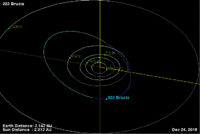323 Brucia
| Discovery [1] | |
|---|---|
| Discovered by | M. F. Wolf |
| Discovery site | Heidelberg Obs. |
| Discovery date | 22 December 1891 |
| Designations | |
| MPC designation | (323) Brucia |
| Pronunciation | /ˈbruːsiə/ BREW-see-ə |
Named after |
Catherine Wolfe Bruce [2] (American philanthropist) |
| 1934 JC · A923 JA | |
|
main-belt · (inner) Phocaea [3] · ex-Mars-crosser[4] | |
| Orbital characteristics [1] | |
| Epoch 4 September 2017 (JD 2458000.5) | |
| Uncertainty parameter 0 | |
| Observation arc | 125.35 yr (45,785 days) |
| Aphelion | 3.0979 AU |
| Perihelion | 1.6662 AU |
| 2.3820 AU | |
| Eccentricity | 0.3005 |
| 3.68 yr (1,343 days) | |
| 106.64° | |
| 0° 16m 5.16s / day | |
| Inclination | 24.230° |
| 97.398° | |
| 291.26° | |
| Physical characteristics | |
| Dimensions |
27.714±0.300 km[5] 29.23±2.92 km[6] 32.395±0.317 km[7] 35.82±1.7 km[4][8] 37.29±0.76 km[9] |
|
9.46 h[10] 9.4602±0.0001 h[11] 9.463±0.005 h[12] 10 h[4] | |
|
0.165±0.007[9] 0.1765±0.018[8] 0.2174±0.0421[7] 0.265±0.053[6] 0.295±0.046[5] | |
|
Tholen = S [1][4] B–V = 0.893[1] U–B = 0.480[1] | |
| 9.09±0.58[13] · 9.73[1][4][6][7][8][9] | |
|
| |
323 Brucia (/ˈbruːsiə/ BREW-see-ə or /ˈbruːʃə/ BREW-shə) is a stony Phocaea asteroid and former Mars-crosser from the inner regions of the asteroid belt, approximately 33 kilometers (21 miles) in diameter. It was the first asteroid to be discovered by the use of astrophotography.[14]
Description

Brucia was also the first of over 200 asteroids discovered by Max Wolf, a pioneer in that method of finding astronomical objects. Discovered on December 22, 1891, it was named in honour of Catherine Wolfe Bruce, a noted patroness of the science of astronomy, who had donated $10,000 for the construction of the telescope used by Wolf.[2][15]
The asteroid is a member of the Phocaea family (701),[3] a large family of stony S-type asteroids with nearly two thousand known members.[16]:23 It was an outer Mars-crossing asteroid with perihelion less than 1.666 AU[1] until July 2017. For comparison, asteroid 4222 Nancita will become a Mars-crosser in June 2019. (6454) 1991 UG1 was a Mars-crossing asteroid until January 2016.[17]
Brucia has a synodic rotation period of 9.463 hours (as of 1998).[4] According to the survey carried out by the Infrared Astronomical Satellite, Brucia measures 35.82 kilometers in diameter and its surface has an albedo of 0.1765.[8]
References
- 1 2 3 4 5 6 7 "JPL Small-Body Database Browser: 323 Brucia" (2017-04-30 last obs.). Jet Propulsion Laboratory. Retrieved 1 November 2017.
- 1 2 Schmadel, Lutz D. (2007). Dictionary of Minor Planet Names – (323) Brucia. Springer Berlin Heidelberg. p. 42. ISBN 978-3-540-00238-3. Retrieved 1 November 2017.
- 1 2 "Small Bodies Data Ferret". Nesvorny HCM Asteroid Families V3.0. Retrieved 1 November 2017.
- 1 2 3 4 5 6 "LCDB Data for (323) Brucia". Asteroid Lightcurve Database (LCDB). Retrieved 1 November 2017.
- 1 2 Masiero, Joseph R.; Grav, T.; Mainzer, A. K.; Nugent, C. R.; Bauer, J. M.; Stevenson, R.; et al. (August 2014). "Main-belt Asteroids with WISE/NEOWISE: Near-infrared Albedos". The Astrophysical Journal. 791 (2): 11. arXiv:1406.6645. Bibcode:2014ApJ...791..121M. doi:10.1088/0004-637X/791/2/121. Retrieved 1 November 2017.
- 1 2 3 Alí-Lagoa, V.; Delbo', M. (July 2017). "Sizes and albedos of Mars-crossing asteroids from WISE/NEOWISE data" (PDF). Astronomy and Astrophysics. 603: 8. arXiv:1705.10263. Bibcode:2017A&A...603A..55A. doi:10.1051/0004-6361/201629917. Retrieved 20 March 2018.
- 1 2 3 Mainzer, A.; Grav, T.; Masiero, J.; Hand, E.; Bauer, J.; Tholen, D.; et al. (November 2011). "NEOWISE Studies of Spectrophotometrically Classified Asteroids: Preliminary Results" (PDF). The Astrophysical Journal. 741 (2): 25. arXiv:1109.6407. Bibcode:2011ApJ...741...90M. doi:10.1088/0004-637X/741/2/90. Retrieved 1 November 2017.
- 1 2 3 4 Tedesco, E. F.; Noah, P. V.; Noah, M.; Price, S. D. (October 2004). "IRAS Minor Planet Survey V6.0". NASA Planetary Data System. Bibcode:2004PDSS...12.....T. Archived from the original on 3 June 2016. Retrieved 1 November 2017.
- 1 2 3 Usui, Fumihiko; Kuroda, Daisuke; Müller, Thomas G.; Hasegawa, Sunao; Ishiguro, Masateru; Ootsubo, Takafumi; et al. (October 2011). "Asteroid Catalog Using Akari: AKARI/IRC Mid-Infrared Asteroid Survey". Publications of the Astronomical Society of Japan. 63 (5): 1117–1138. Bibcode:2011PASJ...63.1117U. doi:10.1093/pasj/63.5.1117. Retrieved 1 November 2017. Online catalog
- ↑ Schober, H. J.; Erikson, A.; Hahn, G.; Lagerkvist, C. I.; Oja, T. (November 1993). "Physical Studies of Asteroids. Part XXVI. Rotation and Photoelectric Photometry of Asteroids 323, 350, 582, 1021 and 1866". Astronomy and Astrophysics Supplement. 101 (3): 507. Bibcode:1993A&AS..101..499S. Retrieved 1 November 2017.
- ↑ Behrend, Raoul. "Asteroids and comets rotation curves – (323) Brucia". Geneva Observatory. Retrieved 1 November 2017.
- ↑ Warner, Brian D. (July 2014). "Asteroid Lightcurve Analysis at CS3-Palmer Divide Station: 2014 January-March". The Minor Planet Bulletin. 41 (3): 144–155. Bibcode:2014MPBu...41..144W. ISSN 1052-8091. Retrieved 1 November 2017.
- ↑ Veres, Peter; Jedicke, Robert; Fitzsimmons, Alan; Denneau, Larry; Granvik, Mikael; Bolin, Bryce; et al. (November 2015). "Absolute magnitudes and slope parameters for 250,000 asteroids observed by Pan-STARRS PS1 - Preliminary results". Icarus. 261: 34–47. arXiv:1506.00762. Bibcode:2015Icar..261...34V. doi:10.1016/j.icarus.2015.08.007. Retrieved 1 November 2017.
- ↑ Campbell, W. W. (1892). "Discovery of Asteroids by Photography". Publications of the Astronomical Society of the Pacific. 4 (26): 264. Bibcode:1892PASP....4..264C. doi:10.1086/120521.
- ↑ "323 Brucia". Minor Planet Center. Retrieved 1 November 2017.
- ↑ Nesvorný, D.; Broz, M.; Carruba, V. (December 2014). "Identification and Dynamical Properties of Asteroid Families" (PDF). Asteroids IV: 297–321. arXiv:1502.01628. Bibcode:2015aste.book..297N. doi:10.2458/azu_uapress_9780816532131-ch016. Retrieved 1 November 2017.
- ↑ Webcite archive of asteroid 6454 with Epoch 2016
External links
- Asteroid Lightcurve Database (LCDB), query form (info)
- Dictionary of Minor Planet Names, Google books
- Asteroids and comets rotation curves, CdR – Observatoire de Genève, Raoul Behrend
- Discovery Circumstances: Numbered Minor Planets (1)-(5000) – Minor Planet Center
- 323 Brucia at AstDyS-2, Asteroids—Dynamic Site
- 323 Brucia at the JPL Small-Body Database
